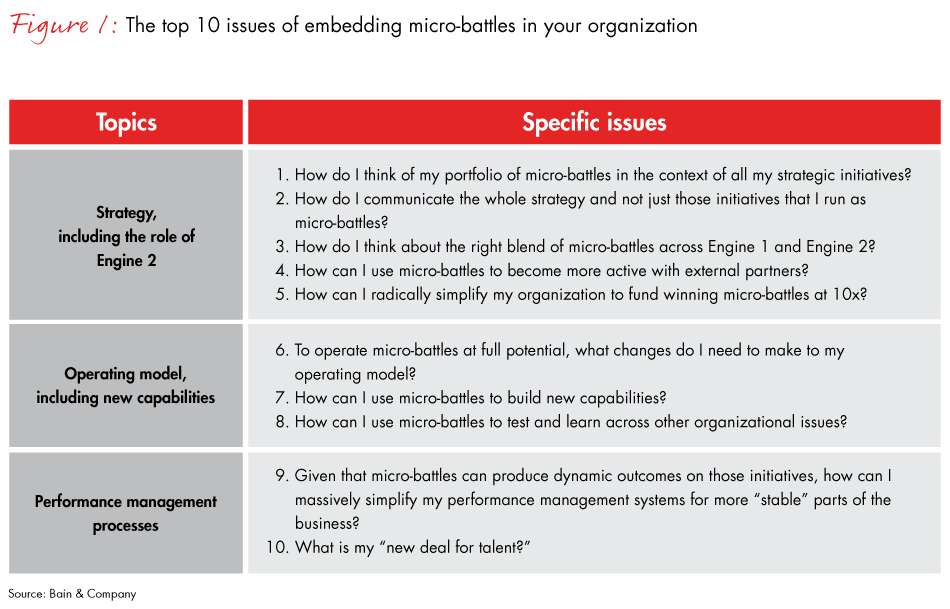Founder's Mentality Blog
 }
}
Congratulations. You’re running a number of micro-battles and beginning to address some tough scaling issues, where you’ve had to:
1. Convert individual prototypes into Repeatable Models® that can be rolled out across the company.
2. Amplify the impact of the portfolio of micro-battles to help you achieve full potential for the business as a whole.
These are the core scaling skills demanded of the scale insurgent. We’re assuming you’re not a master, but you’re a lot better at these two skills then you were a year ago (please read “Scaling as a Capability: 10 Lessons from the Masters”). In our language, you’re beginning to approach Stage 4 of micro-battles, asking yourself, “How do I embed the micro-battle approach into the normal ways of working?” This blog sets out the challenges you’ll face. We’ll work through five common questions:
1. When should I start thinking about embedding micro-battles into my normal ways of working?
The short answer is: Once you’re running micro-battles at scale. We define this as the moment when (1) you’ve taken 5 to 10 individual micro-battles from prototype, to repeatable model, to enterprise results, and (2) greater than 50% of your executive agenda is focused on managing the portfolio of micro-battles. The long answer is: Don’t rush it. Starting and running micro-battles is an “unnatural act” that will create tension with your management team and shake things up. Don’t rush to normalize. Enjoy the chaos and the uncomfortable ride. Take advantage of the tensions micro-battles will create in your normal ways of doing things and embrace the conflict.
2. What are biggest benefits from embedding micro-battles into normal ways of working?
We see four major benefits of moving to Stage 4. First, you signal to your direct reports that micro-battles aren’t going away, and you expect most initiatives will be run through micro-battles. Everyone will understand this is not a fad, an idea du jour, but how you will manage things going forward. Second, you signal to the fuller organization that this is a new way of working. They’ll see that being on a winning micro-battle team is a great way to work directly with senior leaders and get results. This encourages more flexibility in your team and less concern about climbing the hierarchy in their individual siloes. Third, you’ll get better at it. Running micro-battles is a skill. You’ll improve with time. Scaling is an absolutely critical skill, and you’ll get better at it as well. Over time, you’ll develop and nurture the scaling community. Fourth, third parties, including your customers, will see you’re sticking with micro-battles and will want to join the fun. As you develop a track record for co-creation with customers, they will bring you more and more issues so that you can work together for solutions. The more you’re seen as a good partner of choice with external parties, the better your dance partners will be.

Micro-battles
Want to learn more about the journey to scale insurgency? Explore the Bain Micro-battles System℠, step by step.
3. What are the biggest challenges?
There are two big challenges. First, you’ll need to stop a lot of stuff if you’re going to add micro-battles to the corporate checklist. In particular, you’ll have to adapt and simplify the way you do performance management, budgeting and planning. There are simply not enough hours in the day to do all the old stuff in the normal way and add all the hours required to run a portfolio of micro-battles. Second, you’ll have to create a “new deal for talent” if you’re going to run micro-battles at scale for the long term. Your current systems of rewards and review are not robust enough to manage teams of people working on micro-battles over multiple years. Change is a good thing, because it will force you to figure out how to operate as a “firm of the future” where your people are working in a far more dynamic way. But you’ll have to change, and change is never easy.
4. Is there a checklist of questions to address?
Yes. There are 10 key issues within your strategy, operating model and performance management process that need to be addressed (see Figure 1).


5. Who takes this on, the CEO or someone else?
The short answer is the CEO. Embedding micro-battles is the CEO’s job. The long answer is that a CEO should appoint an existing direct report or head of a transformation office to integrate micro-battles into the same process where all transformational initiatives are housed. Not to be too blunt here, but we have a simple rule. If your transformation office is viewed as the voice of the customer, the voice of the front line, then put all micro-battle initiatives there. Good home. If your transformation office is seen as a staff role, filled with compliance matrices and people that gather no smiles on elevators, keep micro-battles away. There’s a separate question about what went wrong with your transformation office, but for our purposes in this blog, we’re out to protect the brand of micro-battles.

Transformation Through Technology: A Vision for Embedding Micro-battles
By taking the four steps toward "transformation through technology," leaders can unleash full potential.
Great Repeatable Models® and Repeatable Models® are registered trademarks of Bain & Company, Inc.